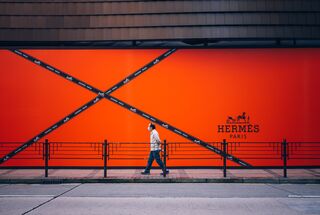Consumer Behavior
Why Does a Hermes Birkin Handbag Cost $40,000?
Its iconic status, managed rarity, and economic appreciation drive the price.
Posted May 17, 2021 Reviewed by Davia Sills
Key points
- The Hermes Birkin bag is a unique ultra-luxury product whose astronomical price cannot be explained by functional and emotional value factors.
- Its iconic luxury status is derived from a carefully managed and sustained rarity and desire stoked by clever marketing.
- It is also widely regarded as a good financial investment because it has appreciated in value over decades.
“[Luxury products are] items that serve little purpose in the lives of consumers except to fulfill dreams. And those dreams don’t come cheap.” —Suzy Wetlaufer
We live in a time when many of us are concerned about economic inequality and focused on getting the most out of every dollar. People go to war over a $4 price discrepancy in a Chinese takeout order and call in death threats when a business adds a modest $2 Covid-19 surcharge to cover its expenses. Others are Kondo-ing their lifestyles, shedding possessions, and embracing spartan living. Yet hardly anyone bats an eyelid when celebrities carry handbags costing over $100,000 or have handbag collections worth millions of dollars.
At the center of this consumerist dissonance sits the Hermes Birkin handbag, the holy grail of luxury products. The price of a single Birkin bag ranges from $9,000 to $500,000 (see video). Most Birkin bags cost more than the average American household makes in one year. Even more intriguing than the exorbitant prices is the fact that many personal finance experts consider buying a Birkin bag as a sign of prudent affluence—an act of indulgent consumption tempered with financial savvy.
How can buying a handbag that costs tens of thousands of dollars be considered a smart thing to do? And how can something normally an instrument of practicality cost so much money? (Keep in mind that a similarly shaped brand-new handbag can be purchased on Amazon for around 12 dollars). The reasons why wealthy consumers eagerly shell out tens or hundreds of thousands of dollars for a Birkin bag provide fascinating insights into the psychology of luxury consumption. It's a bit more complicated than you might think.
High-quality materials, but that doesn’t explain the price
The average Birkin bag takes about 20-25 hours of expert labor to make. It is entirely handmade with costly materials, like exotic animal skins, diamonds, palladium, and gold-plated hardware (see video below). It also has some other quite desirable properties. For example, it comes in a variety of styles and colors, making each piece one-of-a-kind. But like most ultra-luxury products, the raw materials and labor costs are a small fraction of the price tag. As Daniel Langer points out, “product qualities are rarely the main driver of the [customers’] willingness to pay” for luxury goods.
A consumer psychology truism is that consumers’ perceptions of value are divorced from the actual value. There is often no relationship between what something costs to make and what people are willing to pay for it. It is the consumer’s perceptions of value, not the actual value, that drive the consumer's willingness to pay.
A good marketer’s task, then, is to raise customer perceptions of value in every way they can legally and ethically do so. For luxury products, in particular, the marketing facets—the brand’s history and heritage, the product’s origin story, where it is sold, who else buys it, and most importantly, its rarity—more than the product itself, are far more diagnostic of price. As every good salesperson knows, it is often the sizzle that sells the steak more than the meat quality.
The Birkin bag’s iconic status
Hermes, the parent brand, has both an illustrious history and a compelling origin story. Both contribute to the Birkin's aura. However, the relationship between a luxury brand like Hermes and its iconic product, the Birkin bag, is a bit more complicated and also asymmetric.
Not every Hermes bag enjoys the same level of status and pricing power that the Birkin bag does. Another line of bags sold by Hermes called the Kelly bag (named after the actress Grace Kelly) is expensive and in demand, but it is not quite as iconic and sells for considerably lower average prices. So do other Hermes products, like belts and scarves (relatively speaking).
The Birkin bag’s success is partly serendipitous and partly the result of clever marketing. It wasn’t successful in the first decade since its introduction in 1984, and its popularity increased gradually through the 1990s and 2000s. And the company has done at least one thing to bolster the Birkin bag’s iconic status deliberately. They have made it very, very difficult even for wealthy consumers to buy the bag.
The two laws of luxury marketing
The cornerstone of an ultra-luxury brand’s value and the driver of its astronomical prices is an extreme rarity. The first law of luxury marketing is that you can't sell a product that is easily and widely available for a very high price. Rarity breeds desire, and collective desire sends consumers' willingness to pay into the stratosphere.
The second law of luxury marketing is that you should make many, many people, the unwashed masses, so to speak, crave the item. These are the people who cannot afford the item and are unlikely to ever possess it, but they talk about it and pine for it. I call this aspect of marketing "managing the desire" of consumers.
Desire management can be done in many ways, through glitzy advertising, through sponsoring events like a Formula 1 race or a major golf tournament, and these days, by getting mega-celebrities like the Kardashians or Cardi B to brandish the item. When the hoi polloi know every single detail about your brand and are thirsty for it, but it sits well out of their grasp, that's when you have created an ultra-luxury brand. (Ferrari is another example.)
The rarity principle
These two laws of luxury marketing—managed scarcity and managed desire—together make the rarity principle, which is that ultra-luxury items are ultra-rare, and beyond the reach of almost everyone. The rarity principle implies that there should be far fewer numbers of the product available than the number of consumers that want it and have the means to buy it. In other words, ultra-luxury brands operate like bouncers at a popular club. They deny most wannabes in the long line of those who want to get in and keep them out, leaving them full of envy for the chosen few who get in.
The rarity principle makes a Pagani Huayra car worth $3.4 million or a bottle of Balthazar Château Margaux 2009 wine worth $195,000. By design, only about 30 Pagani Huayras are manufactured every year, and only six bottles of the Balthazar were ever made, far too few for the clamoring, deep-pocketed, affluent set of global consumers who desperately want to get their hands on these things for no other reason than the fact that they are so hard to get.
The rarity principle partly explains the Birkin bag's success. Only about 12,000 of these bags are produced each year. On the demand side, however, hundreds of thousands of affluent movie stars, business executives, social media influencers, WAGs, and other wealthy buyers the world over are desperate to own a Birkin bag, and once they do, to start building a collection of these bags.
The denial and exclusivity also extend to the process of purchasing a Birkin bag. Say I suddenly won the lottery for a million dollars and (for some incomprehensible reason) wanted to buy a Birkin bag. If I walked into a Hermes store and asked to purchase one, I would literally be laughed at and shown the door. You can't just walk into a Hermes store off the street and buy a Birkin bag, even if your pocket is full of cash. The bouncer rule is at work.
There aren’t even any waiting lists to get on. Almost unbelievably, the only way a shopper can buy a Birkin bag directly from Hermes is if a company salesperson offers one to them. Only the very top-of-the-top-tier ultra-luxury products are sold in this Bizzaro World way, where salespeople deign to sell, and customers gratefully open their wallets and accept if and when they are offered.
What's more, the bar for getting such invitations is high: The consumer has to be a regular shopper and spend a certain amount of money at Hermes stores, presumably tens of thousands of dollars, before they are invited to buy a Birkin bag. What’s more, their previous level of spending dictates which Birkin bag is offered to them. It’s far easier but a lot more expensive and not as Instagram-worthy or social media bragging-worthy to buy a Birkin bag from a reseller.
The rare consumer product that is a good investment
But that's not the whole story. There's another huge reason why Birkin bags cost $40,000. The vast majority of consumer products lose value rapidly after they are purchased. For example, a car loses 20 percent of its value in its first year and 60 percent within five years, PCs lose half their value within a year, and so on.
That is not the case for Birkin bags. Consumers who are fortunate enough to buy a bag directly from Hermes at the listed price can expect to earn a 50 percent to 100 percent premium if they decide to immediately resale their bag. This is a very unusual property, even by the standards of other luxury products.

Birkin bags fall in the small set of iconic ultra-luxury products that appreciate in value, particularly when they are purchased and stored without ever being used. They are treated as investments by many consumers and seen as equivalent (or even superior) to buying stocks, real estate, or other collectibles. There is some evidence that Birkin bags perform well as investment vehicles.
Nowadays, investors can even buy shares and become fractional owners of a Birkin bag, leading the American financial TV channel CNBC to observe that “Handbags have officially become an asset class.” In other words, you don't have to be a handbag aficionado to buy a Birkin bag. Another benefit is that Birkin bag owners have many venues to sell their bags, including auction houses like Christie’s, online resale sites, like theRealReal and Privé Porter, or even directly through Instagram.
It's not one thing; it's the composite
There are very few products, even ultra-luxury ones, like the Birkin bag. A unique combination of different factors is at work—its global popularity cultivated over decades, the iconic luxury status derived from a carefully managed and sustained rarity, the mass desire stoked by clever marketing, and its widespread acknowledgment by personal finance experts as a high-performing investment asset because of value appreciation over decades. These factors collectively explain why, in this age of economic inequality, minimalism, and frugality, a single Birkin bag costs $40,000, and many people will still happily pay the price. And indications are that Birkin bag prices are only going higher.
We will let British actress Jane Birkin, after whom the bag is named, have the last word:
“We use some of the money [that Hermes contributes from Birkin bag sales to her charity] to feed the poor people who can’t afford to eat in France, and I sold one of my Birkin bags for $163,000 to help the Japanese Red Cross. So that rather trivial piece of heavy luggage has done a lot of good in the world.”




